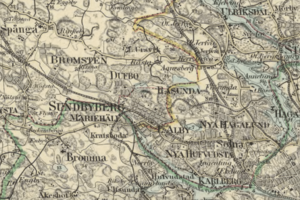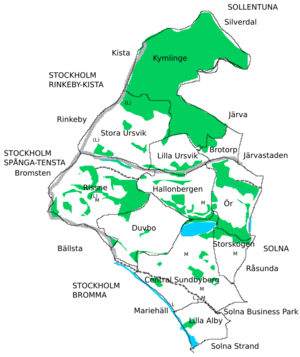Sundbyberg Municipality facts for kids
Quick facts for kids
City of Sundbyberg
Sundbybergs stad
|
||
|---|---|---|

Fountain on Sundbybergs torg (square) in Central Sundbyberg
|
||
|
||
 |
||
| Country | Sweden | |
| County | Stockholm County | |
| Seat | Hallonbergen, part of Stockholm | |
| Area | ||
| • Total | 8.8154 km2 (3.4036 sq mi) | |
| • Land | 8.7054 km2 (3.3612 sq mi) | |
| • Water | 0.11 km2 (0.04 sq mi) | |
| Area as of January 1, 2010. | ||
| Population
(June 30, 2012)
|
||
| • Total | 38,180 | |
| • Density | 4,331.1/km2 (11,217.4/sq mi) | |
| Demonyms |
|
|
| Time zone | UTC+1 (CET) | |
| • Summer (DST) | UTC+2 (CEST) | |
| ISO 3166 code | SE | |
| Province | Uppland | |
| Municipal code | 0183 | |
| Website | www.sundbyberg.se | |
| Density is calculated using land area only. | ||
Sundbyberg Municipality (also known as Sundbybergs kommun or Sundbybergs stad) is a special area in Stockholm County, located in east-central Sweden. It's just north of the capital city, Stockholm. Sundbyberg is completely part of the Stockholm urban area, meaning everyone living there lives in a city setting.
Sundbyberg became its own town in 1888, separating from Bromma. It was officially named a "city" in 1927. Later, in 1949, some parts of Solna Municipality and Spånga Municipality were added to Sundbyberg. Today, Sundbyberg is the smallest municipality in Sweden by land area, covering about 8.83 square kilometers (3.41 sq mi). However, it is also the most densely populated, meaning many people live close together. Even though it's called a "city," this title doesn't have a special legal meaning in Sweden anymore.
Contents
History of Sundbyberg
For a long time, Sundbyberg was mostly farmland. Rich families from the city used it as a summer getaway. In 1863, a man named Anders Petter Löfström bought almost all the land, including the Duvbo Estate. He then started building houses there.
The first land for factories was sold in 1870. After that, the town grew quickly with a railroad, more houses, industries, and public services. A. P. Löfström even gave land for roads, parks, schools, and a church to the municipality.
In 1888, Sundbyberg officially became its own municipality with 1,133 residents. At first, it only included Central Sundbyberg and the undeveloped area called Storskogen. In its early years, Sundbyberg was known for its local beer and lively political discussions. Land was mainly sold to workers and businesses. Because there weren't many public services, people worked together to build their community.
Suburbs like Lilla Alby and Mariehäll were built next to Sundbyberg in the 1880s, and Duvbo around 1900. Trains stopped in Sundbyberg, but not very often. Most people used steamboats to travel. A tram line from Stockholm reached the municipal border in 1910 and extended into Sundbyberg in 1928. This tram service ran until 1959.
Modern Development of Sundbyberg
In 1941, a new city plan was made. It suggested building "lamellhus," which are rectangular apartment buildings, usually with four floors. This led to many old wooden houses in Sundbyberg being torn down in the 1940s. Brick or concrete buildings were kept. Many factory buildings were also turned into homes. As housing prices went up, Sundbyberg became a very crowded suburb and lost most of its industrial feel.
By 1946, Sundbyberg had 15,000 residents. The municipality bought Storskogen, and the first homes there were built in 1952. In 1949, parts of Spånga municipality, including Duvbo and Ursvik, were given to Sundbyberg. Lilla Alby also moved from Solna municipality to Sundbyberg at the same time.
Since the 1950s, Sundbyberg has added a new district almost every decade. Ör was built in the 1960s, followed by Hallonbergen and its metro line in the 1970s. Rissne and its metro line came in the 1980s. More recently, Brotorp and Stora Ursvik were developed in the 2000s.
Economy in Sundbyberg
Sundbyberg has about 50,000 residents living in around 20,000 homes. The municipality aims to have one job for every household. In 2015, there were about 23,000 jobs available. This means Sundbyberg is not just a "bedroom suburb" where people live and travel to Stockholm for work. Instead, many people also travel to Sundbyberg for their jobs. About 19,000 commuters travel in each direction every day. The unemployment rate in Sundbyberg is usually lower than the average for Sweden.
In its early days, Sundbyberg had a lot of factories, and most people worked in industry. However, by the 1940s, most of these industries had left. By the 1970s, warehouses and IT companies started to move in. Today, the service industry is the biggest, with many office workers. This is because Sundbyberg has become more central as Stockholm has grown, and public transport has improved.
Common Jobs in Sundbyberg
Some of the most common jobs for people working in Sundbyberg include:
- IT developers
- Bankers
- Human resources staff
- Secretaries
- Business sellers or purchasers
- Accountants
- Retail clerks
- Truck or bus drivers
- Teachers
- Tax collectors
There are office areas in Central Sundbyberg (Sundbyberg centrum and Allén), Rissne (Ursviks Entré), and Hallonbergen (Sundby Park).
Shopping and Town Centre
Unlike many other suburbs around Stockholm, Sundbyberg has a real town center. The Central Sundbyberg area has many nice shops, which makes the city feel a bit more independent. There are also smaller groups of stores near the Rissne and Hallonbergen metro stations. Large shopping centers nearby, like Bromma Blocks and Mall of Scandinavia, have made it harder for a big shopping center to be built in Central Sundbyberg.
Population in Sundbyberg
Population Growth Over Time
| Year | Population |
|---|---|
| 1970 |
28,085
|
| 1975 |
26,995
|
| 1980 |
25,717
|
| 1985 |
28,516
|
| 1990 |
31,308
|
| 1995 |
31,803
|
| 2000 |
33,868
|
| 2005 |
34,016
|
| 2010 |
38,633
|
| 2015 |
46,110
|
| 2019 |
52,414
|
| 2020 |
52,669
|
The population of Sundbyberg has grown a lot over the years. In 1970, there were about 28,000 people. By 2020, this number had almost doubled to over 52,000 residents.
People with International Backgrounds
As of December 31, 2017, about 40.93% of Sundbyberg's population had an international background. This means they were either born outside Sweden or had two parents born outside Sweden. This number has increased over time; in 2002, it was about 25.24%.
Many people living in Sundbyberg were born in other countries. In 2017, about 14,954 people (30.26%) were born outside Sweden. The countries with the most people living in Sundbyberg include various countries in Asia, Europe, Africa, and the Middle East, as well as Finland.
Public Transport in Sundbyberg
Sundbyberg has a great public transport system, part of the larger Stockholm network. It has several metro stations, a train station, and many bus routes. Even some main line trains stop in Sundbyberg.
The Tvärbanan light rail service was extended to pass through Central Sundbyberg in 2013. Its tracks are laid in the street, and it has two stops within the municipality. Construction for a new light rail line from Ulvsunda to Kista, which will go through Rissne and Stora Ursvik, began in 2018.
Districts of Sundbyberg
Sundbyberg is divided into several districts, each with its own character:
- Brotorp
- Central Sundbyberg
- Duvbo
- Hallonbergen
- Lilla Alby
- Lilla Ursvik
- Kymlinge
- Rissne
- Stora Ursvik
- Storskogen
- Ör
Sports Clubs in Sundbyberg
Sundbyberg is home to several sports clubs, including:
- Sundbybergs IK
- Storskogens SK
Images for kids
See also
 In Spanish: Municipio de Sundbyberg para niños
In Spanish: Municipio de Sundbyberg para niños











